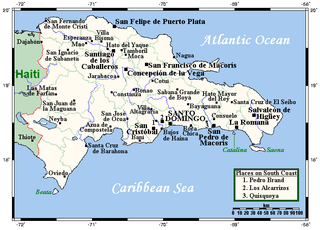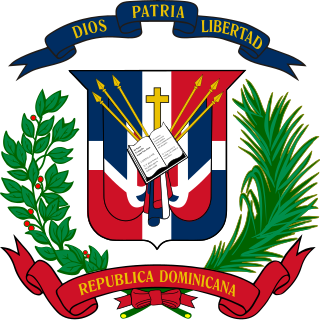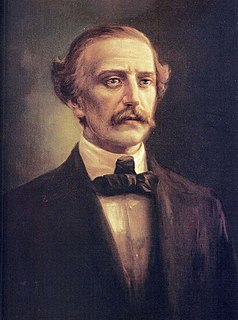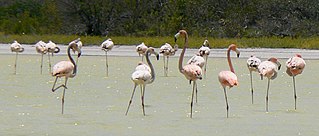
The Dominican Republic is a country located in the island of Hispaniola, in the Greater Antilles archipelago of the Caribbean region. It occupies the eastern five-eighths of the island, which it shares with the nation of Haiti, making Hispaniola one of two Caribbean islands, along with Saint Martin, that are shared by two sovereign states. The Dominican Republic is the second-largest Caribbean nation by area at 48,671 square kilometers (18,792 sq mi), and third by population with approximately 10 million people, of which approximately three million live in the metropolitan area of Santo Domingo, the capital city.

The Dominican Republic is a country in the West Indies that occupies the eastern five-eighths of Hispaniola. It has an area of 48,670 km², including offshore islands. The land border shared with Haiti, which occupies the western three-eighths of the island, is 376 km long. The maximum length, east to west, is 390 km from Punta de Agua to Las Lajas, on the border with Haiti. The maximum width, north to south, is 265 km from Cape Isabela to Cape Beata. The capital, Santo Domingo, is located on the south coast.

Hispaniola is an island in the Caribbean island group known as the Greater Antilles. It is the second largest island in the Caribbean after Cuba, and the most populous island in the Caribbean; it is also the eleventh most populous island in the world.

Dominicans are people who are ethnically associated with the Dominican Republic. Dominican was historically the name for the inhabitants of the Captaincy General of Santo Domingo, and was retained after the nation's independence. The majority of Dominicans reside in the Dominican Republic, although there is also a large Dominican diaspora, mainly in the United States and Spain. The population of the Dominican Republic in 2016 was estimated at 10.2 million by the National Bureau of Statistics of the Dominican Republic.

The Dominican Republic is divided into thirty–one provincias, while the national capital, Santo Domingo, is contained within its own Distrito Nacional.

Pedernales is the southernmost province of the Dominican Republic, including the offshore island of Isla Beata. It was split from Barahona in 1957. Of its 2,074.53 km², 1374 km² belong to the Jaragua National Park.

Juan Pablo Duarte was a Dominican writer, activist, poet, militar and liberal politician who was one of the "founding fathers" of the Dominican Republic. As one of the most celebrated figures in Dominican history, Duarte is considered a folk hero and revolutionary visionary in the modern Dominican Republic, who along with Francisco del Rosario Sánchez and Matías Ramón Mella, organized and promoted the movement, a secret society known as La Trinitaria, that eventually led to the Dominican revolt and independence from Haitian rule in 1844 and the start of a decennial Dominican War of Independence.
Afro-Dominicans are Dominicans of predominant Black African ancestry. They represent 5.26% of the Dominican Republic's population, according to the 1996 electoral census based on Dominican identity cards data, or 10.9% of the Dominican population, according to the 1960 population census.

Jaragua National Park is a national park of the Dominican Republic. Jaragua National Park is located in Pedernales Province in the extreme southwest of the Dominican Republic. Jaragua National Park has an area of 1374 km², with coordinates from 17"28'N to 17'58'N and 71'16'W to 71"44'W, making it the largest protected area in the Caribbean region.

The rhinoceros iguana is a threatened species of lizard in the family Iguanidae that is primarily found on the Caribbean island of Hispaniola, shared by the Republic of Haiti and the Dominican Republic. They vary in length from 60 to 136 centimetres and skin colours range from a steely grey to a dark green and even brown. Their name derives from the bony-plated pseudo-horn or outgrowth which resembles the horn of a rhinoceros on the iguana's snout.
Cabo Beata is the southernmost point of the island of Hispaniola, in the Pedernales Province of the Dominican Republic. The small island of Isla Beata stands about 4 mi southwest of the cape.
Francisca del Espíritu Santo de Fuentes is a Spanish Roman Catholic religious figure. She was the first Prioress of the Congregation of the Dominican Sisters of St. Catherine of Siena in the Philippines.

The following outline is provided as an overview of and topical guide to the Dominican Republic:

Beata Island is a small island on the Caribbean Sea, located 7 km (4 mi) southwest from Cape Beata. Some 12 km (7 mi) SW of it lies the smaller Alto Velo Island. It is part of the Dominican Republic and is roughly triangle-shaped and fairly flat, with an approximate area of 27 km2 (10 sq mi).
Señorita República Dominicana 1956 was held on January 29, 1956. There were 24 candidates who competed for the national crown. The winner represented the Dominican Republic at the Miss Universe 1956. On the top 10 they showed their evening gown so they could go to the top 5. In the top 5 they would answer more questions. This edition would send their first delegate to Miss Universe.

The following is an alphabetical list of topics related to the Dominican Republic.

Alto Velo Island is a small uninhabited island south of the island of Hispaniola in the Caribbean Sea. Its maximum height is about 152 metres above sea level. It lies on an underwater mountain range which continues to Beata Island and the
southwestern coast of the Dominican Republic. It has an area of 1.02 km² and is 1.4 km long, being oval in shape.
Araneagryllus is an extinct monotypic genus of cricket in the subfamily Phalangopsinae with the sole species Araneagryllus dylani. The fossil was recovered in the Dominican Republic from early Miocene Burdigalian stage Dominican amber deposits on the island of Hispaniola. Araneagryllus is the first Phalangopsinae cricket to be described from the fossil record.











